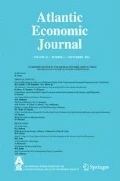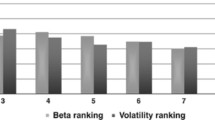Abstract
This paper uses a higher moment capital asset pricing model to characterize the returns of several types of hedge fund indices. The quantile regression approach is used to test for any possible changes in the coefficients of the model. The hypothesis that the parameters are stable across the distribution of returns is tested and rejected. The most stable coefficient is the second moment (beta) coefficient. The higher moment coefficients vary considerably. Alpha returns tend to be positive and significant at the center of the distribution. The importance of higher co-moments (i.e., co-skewness and co-kurtosis) is more prevalent at the tails of the distribution of returns suggesting that there are significant tail risks. These findings could potentially have important implications for portfolio strategies and performance evaluation.
Similar content being viewed by others
Notes
This study covers a much larger time period than Ranaldo and Favre (2005) which included more market cycles. More importantly however, our methodology examines the importance of the market portfolio as well as the co-moments across the entire distribution of returns.
See Getmansky et al. (2015) for an excellent review on the evolution of the hedge fund industry.
It should be noted that the co-skewness and co-kurtosis factors have very low and insignificant correlations with the well-known Fama-French factors. The correlation values range between −0.09 to 0.17.
A complete description of investment styles corresponding to each index is available at the website of the Credit Swiss (2018) Hedge Fund Database.
The intercept in the quantile regression equation is meaningful only at the center of the distribution i.e., for τ = .5.
The use of the AR(1) term in the regression is used to correct for serial correlation in the error term.
References
Ackermann, C., McEnally, R., & Ravenscraft, D. (1999). The performance of hedge funds: Risk, return, and incentives. Journal of Finance, 54(3June), 833–874.
Backstop BarclayHedge (2018). Alternative Investment Databases. Available at: https://www.barclayhedge.com/databases/overview
Bali, T. G., Brown, S., & Caglayan, M. O. (2014). Macroeconomic risks and hedge fund returns. Journal of Financial Economics, 114(1), 1–19.
Brooks, C., and H.M. Kat., 2002. "the statistical properties of hedge fund index returns and their implications for investors." The Journal of Alternative Investments, (fall 2002): 26-44.
Cao, C., Chen, Y., Goetzmann, W. N., & Liang, B. (2018). Hedge funds and stock Price formation. Financial Analysts Journal, 74(3), 54–68.
Carvalhal da Silva, A. (2005). Modeling and estimating a higher order systematic co-moment asset pricing model in the Brazilian stock market. Latin American Business Review, 6, 85–101.
Chang, B. Y., Christoffersen, P., & Jacobs, K. (2013). Market skewness risk and the cross-section of stock returns. Journal of Financial Economics, 107(1), 46–68.
Chiao, C., Hung, K., & Srivastava, S. C. (2003). Taiwan stock market and four-moment asset pricing model. International Financial Markets, Institutions & Money, 13, 355–381.
Credit Suisse (2018). Hedge Fund Indices: www.hedgeindex.com.
Dittmar, R. F. (2002). Nonlinear pricing kernels, kurtosis preference, and evidence from the cross- section of equity returns. Journal of Finance, 57, 369–403.
Fang, E. and C. Almeida., 2019. Are higher-order factors useful in pricing the cross-section of hedge fund returns?" Working Paper, SSRN: https://ssrn.com/abstract=3211540 or https://doi.org/10.2139/ssrn.3211540
Fang, H., & Lai, T.-Y. (1997). Co-kurtosis and capital asset pricing. The Financial Review, 32, 293–307.
French K. (2018). Data Library: mba.tuck.dartmouth.edu/pages/faculty/ken.french/data_library.html.
Friend, I., & Westerfield, R. (1980). Coskewness and capital asset pricing. Journal of Finance, 35, 897–913.
Galagedera, D., Henry, D., & Silvapulle, P. (2003). Empirical evidence on the conditional relation between higher-order systematic co-moments and security returns. Quarterly Journal of Business& Economics, 42, 121–137.
Getmansky, M., Lo, A., & Makarov, I. (2004). An econometric model of serial correlation and illiquidity in hedge fund returns. Journal of Financial Economics, 74(3December), 529–609.
Getmansky, M., Lee, P. A., & Lo, A. W. (2015). Hedge Funds: A Dynamic Industry in Transition. Annual Review of Financial Economics, 7(1), 483–577.
Harvey, C. R., & Siddique, A. (2000). Conditional skewness in asset pricing tests. Journal of Finance, 55, 1263–1295.
Hung, D. C.-H., Shackleton, M., & Xu, X. (2004). CAPM, higher co-moment and factor models of UK stock returns. Journal of Business Finance and Accounting, 31, 87–111.
Hurlin, C., Kouontchou, P., Maillet, B., 2009. "a robust conditional realized extended 4-CAPM". Working Paper, ssrn.com/abstract=134884.
Hwang, S., & Satchell, S. (1999). Modeling emerging market risk premia using higher moments. International Journal of Finance and Economics, 4, 271–296.
Ibbotson, R. G., Chen, P., & Zhu, K. X. (2011). The ABCs of hedge funds: Alphas, betas and costs. Financial Analysts Journal, 27(1), 15–25.
Israel, R., & Ross, A. (2017). Measuring factor exposures: Uses and abuses. The Journal of Alternative Investments, 20(1), 10–25.
Koenker, R. (2005). Quantile regression. New York: Cambridge University Press.
Koenker, R., & Bassett, G. (1978). Regression quantiles. Econometrica, 4, 41–55.
Kraus, A., & Litzenberger, R. H. (1976). Skewness preferences and the valuation of risky assets. Journal of Finance, 31, 1085–1100.
Moreno, D., & Rodríguez, R. (2009). The value of coskewness in mutual fund performance evaluation. Journal of Banking and Finance, 33, 1664–1676.
Pézier, J. (2008). Maximum certain equivalent returns and equivalent performance criteria. Centre Discussion Papers in Finance: ICMA.
Post, T., van Vliet, P., & Levy, H. (2008). Risk aversion and skewness preference. Journal of Banking and Finance, 32, 1187–1187.
Potì, V., & Wang, D. (2010). The coskewness puzzle. Journal of Banking and Finance, 34(8), 1827–1838.
Ranaldo, A., & Favre, L. (2005). How to price hedge funds: From two- to four moment - CAPM. SSRN: UBS Research Paper https://ssrn.com/abstract=474561.
Smith, D. R. (2007). Conditional coskewness and asset pricing. Journal of Empirical Finance, 14, 91–119.
Stulz, R. (2007). Hedge funds: Past, present and future. Journal of Economic Prespective, 21(2), 175–194.
Treynor J.L., and Mazuy K., (1966). "can mutual funds outguess the market?" Harvard Business Review Vol. 43, (July-august 1966).
Vanden, J. M. (2006). Option coskewness and capital asset pricing. Review of Financial Studies, 19, 1279–1320.
Yang, C.-Y., & Chen, M.-C. (2009). The role of co-kurtosis in the pricing of real estate. Journal of Real Estate Portfolio Management, 15, 185–195.
Author information
Authors and Affiliations
Corresponding author
Additional information
Publisher’s Note
Springer Nature remains neutral with regard to jurisdictional claims in published maps and institutional affiliations.
Rights and permissions
About this article
Cite this article
Knif, J., Koutmos, D. & Koutmos, G. Higher Co-Moment CAPM and Hedge Fund Returns. Atl Econ J 48, 99–113 (2020). https://doi.org/10.1007/s11293-020-09659-1
Published:
Issue Date:
DOI: https://doi.org/10.1007/s11293-020-09659-1




